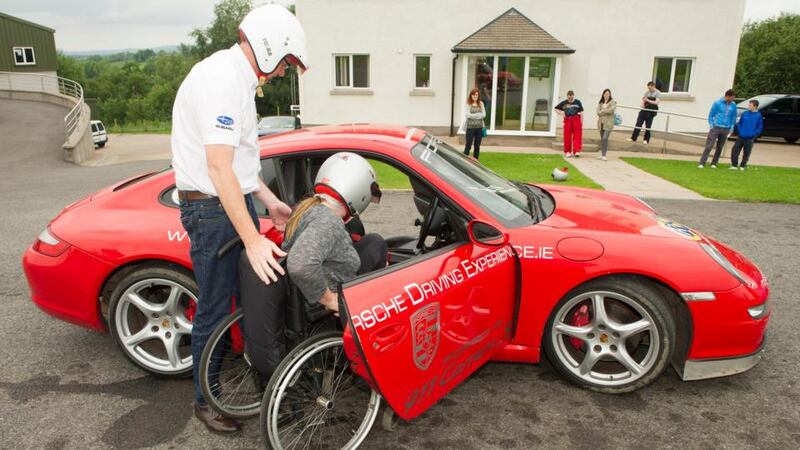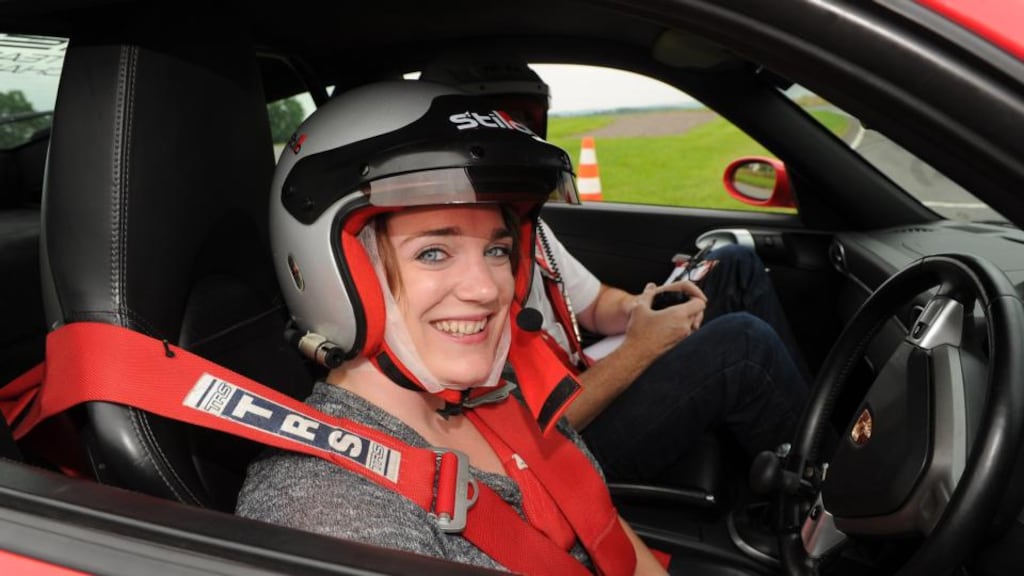‘Trust me. You can do this.” No, this isn’t the opening of a star-studded romcom; these are wise words from rally driver and Rally School Ireland co-owner David Smyth.
The school recently adapted a number of their cars with hand controls so that wheelchair users could take a spin, and, off the back of my wheelchair-access review blog Legless in Dublin, I have been offered the opportunity to take two supercars out on the racing track in Co Monaghan. So, quicker than Top Gear can censor Jeremy Clarkson, I say yes, yes, a thousand times yes.
The school is run by David and his brother Malachy. It caters to individuals and groups of up to 30 who want to burn some rubber. They have a huge range of cars to choose from, including a Porsche, a Ferrari, a Subaru Impreza Turbo, a classic Ford Escort and an Audi Quattro. With an instructor in tow, your main concern is sucking diesel and sucking diesel only. However, if safety is on your mind, every car at the school has a set of foot pedals on the passenger side, so, much like when you were first learning to drive, your instructor can step in at any point if things get too shaky.

My first car of the day is the Porsche 911 Carrera, a sexy little red number with 396 horsepower. Theoretically, this means very little to me, but once you get behind the wheel, you suddenly understand the need for speed and you instantly feel like a millionaire. The 1.1km of paved track has 14 turns in a lap, so this isn’t your regular Sunday drive.
Naively, I think I will be eased slowly into this fast lifestyle. Instead I am carted immediately into the driver’s seat and strapped in tightly.
My co-pilot David commands me to “drive it like you stole it”. My brakes and accelerator are combined together in a push/pull hand control beside the steering wheel, which has an added steering knob to assist. One gentle tap of the accelerator warms up the Porsche and a firmer pull gets it going from zero to 90 in seconds.
Before I reach the first turn on the course, I am giggling like a schoolgirl, high on adrenaline and fear. Everything suddenly makes sense. Colours are brighter, the birds are chirping clearly and the . . . “Brake!” Oh yes, I remember, I am driving a fast-moving vehicle.
Look ahead
The trick to rally driving, I’m told, is to look ahead. When faced with a sharp turn, look past it, brake softly and let the car coast around the corner while you keep your eyes on the next turn. If you brake or accelerate too sharply in a corner, it’s easy to lose control. Once you take the bend, you pick up the speed again. This advice is applicable to all life situations, but especially to rally driving.
We pause for a lunch break and a sit-down, and David says that anyone can drive a rally car. “Our youngest driver is 11 and he puts some of the adults to shame,” he says, as the purring, growling and screeching of the cars quietens, much like nap time at the zoo. “You can be as young as 10 to drive here. The youngest is 11 and the eldest is 78.”
Time for school
David and Malachy set up the school in 1999, with only three cars in their collection. Then, when they had almost 20 cars of different speeds, strengths and vintage, they decided to adapt three of their cars – the Porsche, a Subaru and a Ferrari – so that anyone could come through their doors and give rally driving a go. It all began when a friend of theirs, David Griffin, who uses a wheelchair, asked if they could adapt some of their vehicles. Once Griffin got into the swing of things, says Malachy, he took it upon himself to challenge one of the world’s top rally drivers and a former instructor at the school, Kris Meeke, from Dungannon, Co Tyrone.
“He challenged Kris to basically put him in a chair, get him in the car, get him belted in and do a lap and see how he goes. David was very good, and that’s what we’ve noticed with people in chairs: they can have very good use of their upper limbs and that’s all it takes,” says Malachy. “If you’re in a chair or not, when you’re out in the car, we try to get you to go as fast as we can go.”
After lunch, the Ferrari F355 Berlinetta is waiting for me. This car, nicknamed The Widowmaker, oozes danger. I am, quite frankly, terrified. One does not simply get into a Ferrari; one slinks into a Ferrari, as it is very low to the ground. As fun as it is to slide in, there is no graceful way to get out. Anyway, I slink in and it feels great. The familiar horse on its hind legs practically winks at me. The Ferrari, with the power of 400 horses, is an older and heavier car, but once you get on the track, the movements are fluid. Your body synchronises with the car’s swerves and you become a blood-red cobra darting around.
“Faster, faster. Add more gas,” says Dave. I throw my head back and cackle. This is the Ferrari effect. You go mad with power.
With the wheelchair, I have never done anything as exciting as this. The exclusive world of rallying and supercars has now opened up its doors to everyone, albeit at a high price. Your motoring experience can cost from about €100 to €600, depending on which package you go for, but it is a once-in-a-lifetime opportunity, and – particularly for adrenaline junkies – the buzz is electric.
The average speed lap from the creased-jean-wearing and Lamborghini-buying Top Gear army takes about one minute and 19 seconds to complete 2.82km of track. The Rally School of Ireland track, all 1.1km of it, takes me 54 seconds in the Porsche. The Ferrari, a stronger beast to handle, takes longer to get used to, but if we had more time together, I know we could have started something beautiful.
Until our next encounter, my sweet, drive smoothly.










